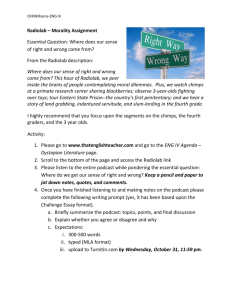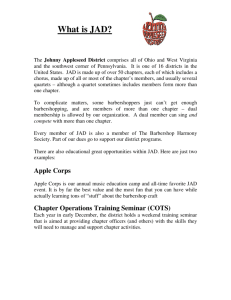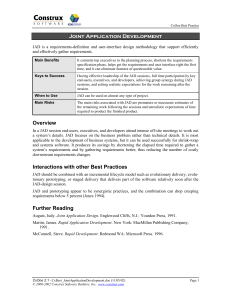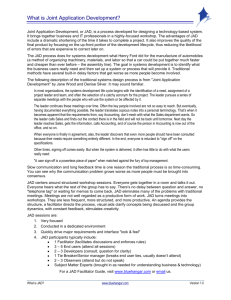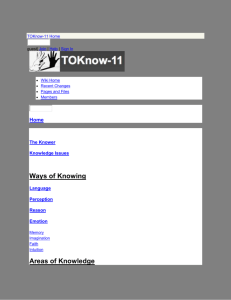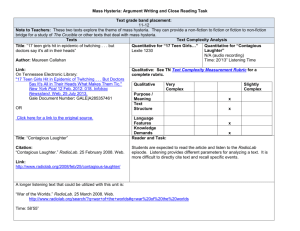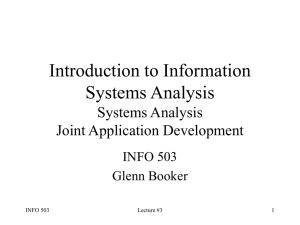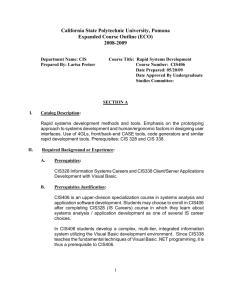“Radiolab: An Appreciation” Manifesto
advertisement
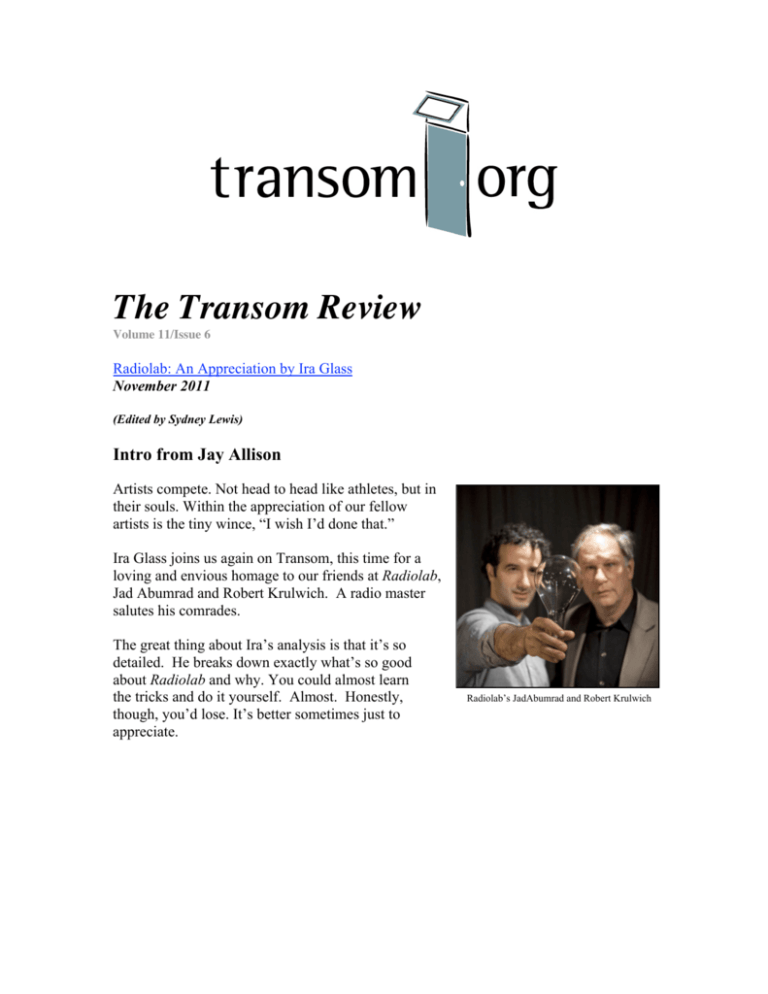
The Transom Review Volume 11/Issue 6 Radiolab: An Appreciation by Ira Glass November 2011 (Edited by Sydney Lewis) Intro from Jay Allison Artists compete. Not head to head like athletes, but in their souls. Within the appreciation of our fellow artists is the tiny wince, “I wish I’d done that.” Ira Glass joins us again on Transom, this time for a loving and envious homage to our friends at Radiolab, Jad Abumrad and Robert Krulwich. A radio master salutes his comrades. The great thing about Ira’s analysis is that it’s so detailed. He breaks down exactly what’s so good about Radiolab and why. You could almost learn the tricks and do it yourself. Almost. Honestly, though, you’d lose. It’s better sometimes just to appreciate. Radiolab’s JadAbumrad and Robert Krulwich The Transom Review – Vol.11/ Issue 6 Radiolab: An Appreciation by Ira Glass I marvel at Radiolab when I hear it. I feel jealous. Its co-creators Jad Abumrad and Robert Krulwich have digested all the storytelling and production tricks of everyone in public radio before them, invented some slick moves of their own, and ended up creating the rarest thing you can create in any medium: a new aesthetic. Take the opening of their show on the mathematics of random chance, stochasticity. The first aesthetic choice Jad and Robert make is that they don’t say you’re about to listen to a show about math or science. They don’t use the word stochasticity. They know those things would be a serious turn off for lots of people. In doing this, Jad and Robert sidestep most of the conventions of a normal science show – hell, of most normal broadcast journalism. I think our fellow public broadcasters do lots of accidentally counterproductive things without thinking twice, things that prevent lots of people from connecting with their work. On the very fine PBS science show Nova, the narration is that chipper TV style that says: “I’m talking to you in a big official voice. I’m talking to you like a grownup who’s teaching you something.” They accidentally make it feel like school. Radiolab avoids that entirely. I love science, but never watch Nova, because of the old-fashioned aesthetics. Nova can be corny. But I never miss Radiolab. The result of keeping mum on this particular point? Rob Walker, writing in the New York Times, admitted something I experienced myself: “I heard several episodes of Radiolab before I figured out that it was supposed to be about science. I thought the ‘lab’ part of the title referred to experimentation with the medium.” A digression but maybe an interesting one. Just as Radiolab rarely says it’s a science show, we made a conscious choice when we started This American Life that although it’s a documentary show, we’d never call it that, and in fact we’d avoid the word whenever possible, because "documentary" sounds like it’s going to be boring. Heavy. Not entertaining. Even I hold my breath a little before tuning in a documentary program, and I make documentaries for a living. Another digression, this time not about me: This question of tone, of how we accidentally alienate potential listeners, is something lots of people in public radio have been talking about lately. A 2010 NPR/SmithGeiger survey: of news consumers who rightly should be in the public radio audience, showed that one of the biggest reasons adults say they choose not to listen to public radio is that they’re put off by the tone. One survey respondent said: “This type of story could be interesting, but the reporter’s voice and intonation is soooo affected, upper class, wasp, Ph.D. student-like, it detracts from the story. She speaks like she is writing a novel.” 2 The Transom Review – Vol.11/ Issue 6 Radiolab has invented a sound that won’t put off smart people who should be in our audience. Simply put: it’s a show that’s out for fun. It’s no surprise that a much younger audience loves Radiolab. It’s no surprise that a huge part of its fan base is people who don’t consider themselves public radio listeners. Okay. Those aesthetics. The stochasticity episode begins with a story that Jad tells Robert, about a young woman named Laura Buxton. She was living in a little English town called Stoke-on-Trent. She took a red balloon, wrote on it “Please return to Laura Buxton” and her address. It was a windy day. She stood in her front yard, held it in the air, and let go. This information is presented quickly and cheerfully. There’s a bounce to the whole thing. Music plays behind. Jad looks at a map, as he’s talking to Laura, naming the cities the balloon passed on its flight across England. It’s visual. Do I need to explain here that part of making great radio is remembering that you always need to give the audience things to look at? The map helps you see the balloon travel across the English countryside, makes the distance palpable and not just an abstract number of miles. When the balloon is all the way on the other side of the country, it descends and touches down in the yard of another young woman. The music exits. A second young woman appears and explains that a neighbor was about to throw it away: Second young woman: And then he saw the label ‘please send back to Laura Buxton and he was like ‘Oh my god.’ There’s an irregular sort of drum hit and a low note begins underneath what’s said next. Robert: Why? Why’d he say ‘Oh my god’? Jad: Okay so check this out. Remember how I told you the first girl who sent the balloon was ten? Robert sort of grunts: Yeah. Jad: The second girl? Who received it? Second girl: Ten years old. Jad: SHE’S ten. Robert (cautiously): Ooookay. 3 The Transom Review – Vol.11/ Issue 6 The low hum underneath their conversation is getting louder and more insistent. Jad: No wait; there’s more. Robert: Better be. Jad: Remember I told you the first girl’s name was Laura Buxton. Robert: Yeah. The low drone music pokes up into the foreground a moment. A note hits. Jad: Well ... girl number two, can you introduce yourself. Second girl: Hi. I’m Laura Buxton. She gives a little laugh. The music comes to a dead stop on another drum hit - which echoes to silence. This all happens very quickly. Robert: What??! Jad: Girl number one: First girl: I’m Laura Buxton Jad: Girl number two: Second girl: I’m Laura Buxton. Robert: They’re BOTH Laura Buxton? Jad: Yes! Robert: No!! Jad: YES! Robert: Both named Laura Buxton?? A dramatic pause. Jad: Yes. Robert: Get out! 4 The Transom Review – Vol.11/ Issue 6 A big violiny music sting. Jad: You. Heard. Me. Right. A sweet old Raymond Scott jazz tune starts bopping underneath him as he talks. Jad: A ten-year-old girl named Laura Buxton lets go of a balloon. Balloon sound effect. Jad: That balloon lands ... Crash sound. Jad: ... in the yard of another ten-year-old girl named Laura Buxton. Robert: Is this for real? Jad: Yes! A few notes of music melody. Jad: I think it might be the strangest thing I’ve ever heard in my life. Second girl: It’s pretty weird. Jad: So weird, we had to get them both into a studio. Tinny voice with a British accent: Hello New York this is London. Can you hear me? Second girl (talking obviously to the engineer in London): So we’re going to like –hear Americans through these? I suppose that as much as I’m enjoying transcribing these bits and staring at how cool they look when you type them out, I should give you the link to listen to them. Here it is. Keep in mind - however this looks on the page - it goes by very, very fast on the radio. Total duration: a minute and six seconds. That’s speedy. There’s a chattiness to it. The back and forth between Jad and Robert – in contrast to most broadcast journalism – is casual. Often it’s funny. Open to digression and disagreement and most of all: enthusiasm. All of this is part of what feels so original. You feel Jad’s excitement over how amazing this story is. There’s a sense of playfulness and discovery to the whole project. They’re having fun: unfaked, unforced, no kidding fun. 5 The Transom Review – Vol.11/ Issue 6 That question, “So we’re going to hear Americans thru these?” is such a nice touch funny in a very understated way. What other radio show would throw in that sweet tiny moment that’s basically the random stuff that’s said while they’re getting the other studio on the line? What Banter’s Good For. All this banter also helps them solve a storytelling problem that would come up for anyone trying to tell the story of the two Laura Buxtons. Consider: the entire point of this story is how completely, amazingly incredible the coincidence is that both girls are named Laura Buxton (other coincidences and the mathematical likelihood of these coincidences follow). For the story to work, the listener really needs the feel the incredibleness of the coincidence. The more he or she feels that, the more punch the whole thing will have. So rather than have Jad narrate the story like any normal public radio reporter – go from a script to quote to script to quote – the theater of having another co-host in there muttering at first “it better get better than this” and then exclaiming “No!” and finally “Is this for real?” sells the incredibleness way more effectively. This is a trick the Planet Money team is using all the time. Having two narrators lets them express amazement, underline what’s funny, manipulate the pacing, pause on a difficult idea and bring up opposing ideas in a very graceful way. And the banter has an aesthetic of its own. Most journalism in our country lacks the sense of joyous discovery one gets in Radiolab. There’s none of the enthusiastic “Yes!” “No!” “Yes!” “You heard me right!” “Get outta here!” But on Radiolab, we listen in as the hosts and the other reporters discover their stories, and we hear their pleasure as they puzzle out the truth. The structure of many of their stories and episodes includes the hosts not understanding something, looking into it, arguing over it, and then coming to some understanding. One of their go-to moves: one of the hosts presents some fascinating findings from a scientific study, and then the other host picks the study apart, point by point. This is part of what makes the show so incredibly listenable. Jad and Robert are on an adventure and they’re bringing us along. I tend to have big pretentious, tiresome thoughts about how important that is. Real journalism – and by that I mean fact-based reporting – is getting trounced by commentary and opinion in all its forms, from Fox News to the political blogs to Jon Stewart. Everyone knows newspapers are in horrible trouble. TV news continually loses ratings. And one way we broadcast journalists can fight back and hold our audience is to sound like human beings on the air. Not know-it-all stiffs. 6 The Transom Review – Vol.11/ Issue 6 One way the opinion guys kick our ass and appeal to an audience is that they talk like normal people, not like news robots speaking their stentorian news-speak. So I only wish more broadcast journalism had such human narrators at its center. I think that would help fact-based journalism survive. But like I say, I’m kind of a nut on this subject. To get that chatty style, Jad and Robert have invented some production techniques that are very different from what most of us use. They’ll come into the studio together with a script that’s halfway between a real script and a list of story beats they know they need to hit. For instance, here’s the script they took into the studio for that Laura Buxton story. Says Jad: “Our studio scripts are a hybrid beast. Much of the script will be a list of loosely written plot points (kind of like a real script but a little sketchier), and those parts are meant to be improvised, but we’ll also mark some passages which have to be read word for word. Like, if we’re dealing with a passage that contains lots of technical writing, there’s no way to improvise that and get it right. But particularly the places where the story turns, or where the hosts are to take different sides of an issue, those moments are always improvised.” They’ll ad lib their way through this so-called “script” a few times, rolling tape the whole time. Then Jad or one of the show’s producers cuts together a version. They listen to it. Then they’ll go back and re-record bits of banter, to make a quicker transition from one section to the next, or to slow down and explain some point more thoroughly, or to set up a piece of tape slightly differently. They’ll do this three or four times, jumping into the studio to make little improvements and adjusting as Jad and the other producers layer in the other production elements, the music and sound. Thus the utterly effortless chitchat that floats you so cheerfully from plot point to character moment to scientific explanation to the next plot point is actually worked over second by second and beat by beat, over the course of weeks. Jad, and Music A word about the music. Jad’s an Oberlin-trained composer so he’s always either writing the music to fit the stories on his show, the way a composer writes a film score, or he adapts other people’s music so well you can’t tell it wasn’t custom made. No other public radio show has this. Radiolab’s Jad Abumrad 7 The Transom Review – Vol.11/ Issue 6 And so you end up with this super-polished production work where every note and phrase and breath is worked out to the microsecond. The timing and entrance of every little note, each of the sound effects, the quotes, the echo on the voices and music, the tinniness or bassy-ness of each element in the mix, it’s all calibrated and machined like an expensive handmade watch. No other radio show sweats the production work to that extent; it’s not even close. And all that meticulous work is in the service of something that’s the opposite of careful and meticulous: this totally chatty, happy, loose, spontaneous-sounding conversation between Jad and Robert and their interviewees. So you have looseness set on top of a perfectly-ordered audio architecture. Dancers freestyling it on an architect’s blueprints. Okay, that metaphor’s forced, but you get the idea. To me, this sounds very new. Sometimes the results astound me with their complexity and deftness. I heard an episode last week – it’s the one they call “Cities” – where in four minutes (starting seven-and-a-half minutes into the show) Jad recreates a science experiment with his own listeners all over the world – Mumbai, Jerusalem, Buenos Aires, Thailand, Liberia, Oslo, Dublin, Copenhagen, Moscow. Each of the listeners lays out a string on the sidewalk in his or her city and takes a stopwatch and counts the speed of footsteps while recording audio of the footsteps. The sheer velocity of this short segment is part of the fun. We jump from person to person and city to city – plus the old 60’s tune “These Boots are Made for Walking” which is reconfigured beat by beat for this purpose – plus Jad explaining the steps of the experiment – plus the scientist who did the original research – plus, a nice touch, a computer-generated voice to read the results. All leading to this intriguing idea about how each city has its own measurable walking speed, which can be shown to exist through direct measurement. And leading to this more novelistic (or maybe it’s just more stoner-ish) thought: who’s beating the drum? Who sets the walking speed? It’s a crazy tour de force of radio production, all the more impressive when you think of the difficulty of organizing a dozen people all over the globe and making them get the right kind of audio, and then sifting down what must’ve been 12 or 15 hours of sound to a compelling, funny, utterly original bit of radio that only lasted four minutes. I don’t know any other radio show would’ve been able to execute the whole thing that fast. I don’t think I could’ve. For one thing, after all that work, you usually make a much bigger deal out of the whole “We reached out to you! All over the globe!” thing. All that effort and trouble, you drag it out for way more than four minutes on the air. But that’s not how they roll on Radiolab. They invented this insanely concise, entertaining way to tell that story, and they have no problem hurtling through it quickly. 8 The Transom Review – Vol.11/ Issue 6 A Unique Editorial Sensibility The editorial vision of the show is also utterly original. What other show takes on the kinds of subjects Radiolab does? What other show would even take up the question of walking speed in different cities, much less invest dozens of hours in manufacturing an original audio experiment? (And BTW they just did a second all-over-the-globe audio inquiry like this one, about tic tac toe.) As Bill McKibben pointed out in the New York Review of Books about Jad and Robert: “In an almost comic attempt to make their job hard, the duo take only the most difficult subjects from science and philosophy: ‘Time, ‘Morality,’ ‘Memory and Forgetting,’ ‘Limits.’” Listening to Radiolab I have the unusual experience where nearly every story is something I’ve never heard of or thought about before, and the stories lead to ideas I’m utterly unfamiliar with. That’s a standard very few of us even aspire to, much less achieve. Some memorable ones, or anyway, some of my personal favorites: • In a show about parasites, there’s the story of an allergy-ridden guy who learns that people who don’t have proper sanitation and live with parasites in their bodies tend not to have allergies (for reasons that are explained in the show). His allergies are ruining his life, so he flies to Africa and trudges barefoot around latrines to infect himself with hookworms. Which – of course – works. Would it be a story if it didn’t? He is cured. (We later ran this one on our show.) Listen to the “Parasites” episode here. • In the Stochasticity show, there’s the story where a math professor has some groups of students flip a coin over and over a hundred times and write down whether it’s heads or tails each time. Other groups of students are supposed to fake it: they write heads or tails a hundred times in a list without flipping a coin. True randomness is so distinct, so easy to spot if you know what to look for, that the professor is always able to spot which of the lists were generated by real coin flips. Listen to the “Stochasticity” episode here. • There was the perfectly-staged character study in the New Normal episode, about a small, conservative town, Silverton, Oregon, and how they ended up with – and embraced – the nation’s first transgender mayor. The structure of this story is something I could teach a class about. It’s amazing. If you listen, note exactly how far into the story we are before the idea shows up of anyone being transgender. I’m guessing Jad and Robert calculated that they wanted listeners to invest in the characters and the town before they made that reveal, that lots of people hear ‘transgender’ and feel either disinterest or hostility. They lay out stakes early without telling us what the story will be about – which is no mean trick. 9 The Transom Review – Vol.11/ Issue 6 There’s also this moment that’s completely offhand and totally poetic at the same time: Jad plops his main character down in an empty movie theater and says “Let’s sit and pretend we’re watching the movie of your life.” We hear the sound of an old movie projector, and they begin. Listen to the “New Normal” episode here. • Another favorite: the story [LINK: http://www.radiolab.org/2011/jan/25/findingemilie/] in an episode called “Lost and Found” about a young woman in a coma that has this amazing bait-and-switch structure where it seems like it’s about the conflict between her boyfriend and her parents but in fact comes to be about life in a coma. Things get said in that story about what it’s like in a coma that I’ll remember for the rest of my life, things I’m sure I’ll mull over someday when actually I’m in a coma. (“Oh no!” I’ll think in my half-dreaming, half-aware haze, “Goddamn Radiolab was right!”) In that story – and this is so rare in any radio story – some key plot twists, really stunning moments to have on tape, occur with a microphone present. So often we all have to rely on getting people to talk about those moments later, in retrospect. There’s no recording of the moment itself. When that story finished playing, the thought crossed my mind: was that the very best radio story I’ve ever heard? Listen to the “Lost and Found” episode here. Flow Radiolab also does a beautiful job figuring out a mix of stories that’ll move us from one idea to the next over the course of an hour. Lots of their episodes have a coherent argument to them, an argument that takes an hour and several stories to lay out. The Stochasticity show was like that for sure, and the Parasites show (where we met parasites who do creepy things and parasites who do useful things). There was an entire hour recently that took up the provocative question: from an evolutionary perspective, why would it be useful for us, or for any creature, to ever help one another? To ever be good? That’s a really hard premise for stories with ideas and emotion and strong characters and interesting plot lines. Imagine for a second having to fill that hour with stories: where would you even start? Jad and Robert take us from the family relations of a guy who invented an equation to explain why anyone would help anyone else to a man who dove in front of a subway car to save a stranger (okay, that’s sort of a normal one that you or I might’ve thought of) to the trenches of World War I, plus lots of other stuff besides. They jam a lot of the world into an hour of Radiolab. It’s a tour of way more exotic and surprising places than most radio shows. Or take an episode they called After Life, which broke format in a number of ways. First, it was a lot of very brief stories, butted together semi-abruptly. Second, it included not only reports about the science of death, but short pieces of fiction. These were by David Eagleman, read by the great, morosely deadpan actor Jeffrey Tambor (Larry Sanders Show anyone? Arrested Development?). 10 The Transom Review – Vol.11/ Issue 6 One story begins: “There are three deaths. The first is when the body ceases to function. The second is when the body is consigned to the grave. The third is the moment, sometime in the future, when your name is spoken for the last time. So you wait in this lobby until the third death. There are long tables with coffee, tea and cookies; you can help yourself. There are people here from all over the world, and with a little effort you can strike up convivial small talk.” The story goes on to describe life in that lobby. Jad invents this murmury soundscape for it, with music I assumed he composed himself for the purpose, it’s so perfect, but that apparently he found somewhere. The feeling the story gives is like nothing I’ve ever heard on the radio. And very different from their normal gig. That whole episode is very different from a normal hour of Radiolab, full of mournful feelings, and one of my favorite hours of radio I’ve ever heard. Their videos are just as good, and very different from the aesthetic of the radio show or, come to think of it, any video I’ve seen any public radio show or public radio station attempt. Their Words video is a little piece of art on its own, with its own rules and aesthetics. I was stunned to learn, talking to Robert Krulwich, that none of the footage in it is found footage. It was all shot with non-actors for this video. Public radio shows and stations that are wondering how to reach all the people who don’t yet know about their programs might consider the cost and the reach of this video. It’s very cost-effective audience outreach: over 700,000 people watched the video on YouTube, and the price to make it was $4000. (Anyone who’s shot video will be stunned at how cheap that is. These were young filmmakers who’ve since moved on from that price point, though there’s an army of other young filmmakers behind them.) What’s striking is the ambition of all this. Jad and Robert seem to be inventing their effects and techniques as they go. I’m a hack in comparison. Everyone else is too. Robert, and DNA. Jad Abumrad’s generation of public radio producers came of age in the last decade, after public radio was already an established national institution. Robert Krulwich is old school. If it weren’t laughable to call anyone in public radio O.G., he’d be O.G. NPR was created in 1970. Robert became a reporter there in 1976. Radiolab’s Robert Krulwich 11 The Transom Review – Vol.11/ Issue 6 The amused, curious spirit that’s at the heart of the Radiolab sound, Krulwich was doing as a solo act back in 1980 on All Things Considered. He even had groundbreaking-forthe-time audio production back then. If I had more patience for searching the Internet, I bet I could find audio of the explanations of Reaganomics he did using "lab mice" (i.e. speeded up voices), or the fake opera “Rato Interesso” he staged in one news report to explain interest rates (inserting audio clips of Fed Chairman Alan Greenspan into real arias) or the story – a personal favorite – where he put all the money in the U.S. economy onto the field of a giant stadium (or anyway, he created the sound of that happening) to explain how governmental borrowing drives up interest rates for the rest of us. Listen to "Heating up With Mice" Listen to "Rato Interesso" When Radiolab began, I’m guessing that a lot of the reporting chops and story sensibility were Robert’s. And on lots of those early episodes it’s Robert playing the skeptical older journalist, questioning Jad, poking at premises. But over the years, that distinction has evaporated and now, in any given episode, it’s just as likely for Jad to knock down Robert’s premises. Sometimes when I listen to the show, I feel like Jad has taken all the key elements of Robert’s 1980 sensibility – the humor, the insistence on entertaining, the surprising story choices, the amused intimate interviews and the chatty narration style – and retooled them for the digital age and a completely different generation. It’s Jad’s ear and astonishing production chops that define the sound of Radiolab, but the DNA of that sound comes from Robert. R.E.S.P.E.C.T. Fascinatingly, WNYC does not seem to treat Jad and Robert as their resident geniuses. WNYC likes them fine. It supported their work before anyone was noticing. And all credit to WNYC for being one of the very few public radio stations who see it as part of their mission to invest in innovative new shows like this and Studio 360 and The Takeaway. But the two guys who are rethinking and reinventing American radio don’t seem to be a big part of the station’s identity. Perhaps inevitably, it’s the daily talk show hosts (and especially the very skillful Brian Lehrer), who log so many more hours on the air, who define that. Meanwhile, around the country, public radio managers seem to appreciate the show and to understand that Jad and Robert are trying something new, but often they broadcast Radiolab at marginal times without the kind of heavy promotion that might befit the most groundbreaking, audience-friendly show of the last decade. (Though to be fair, because Radiolab is not in weekly production, it can be hard to schedule effectively.) The fact that it took the Peabody Awards committee so many years to figure out that Radiolab deserved that honor is a sign that a lot of people used to a more mainstream media sort of excellence don’t always apprehend what’s so special about Radiolab. 12 The Transom Review – Vol.11/ Issue 6 Sometimes it seems like the only people who understand how terrific the show is, are listeners. When I meet public radio fans, and we get to talking about what programs they’re liking these days, Radiolab is the program they want to gush about. For my part, I find it comforting that this level of excellence is so labor intensive that they only can make ten full shows a year (plus, sure, 16 “shorts” that they distribute on the Internet). If they could do an hour of this every week, I think I’d have to quit radio. What would be the point of continuing? How could anyone compete with that? Related Links Ira Glass’ 2004 Transom Manifesto Robert Krulwich’s 2002 Transom Manifesto About Ira Glass Ira Glass is the creator and host of the public radio program This American Life, which is produced by WBEZ Chicago and distributed by Public Radio International. Ira Glass 13 The Transom Review – Vol.11/ Issue 6 Comments Julia Barton – 19 September 2011 What a great and generous and perceptive piece. Love it. Stre – 19 September 2011 I love Radiolab, but I wish they would modulate their sound effects more. The beep at the end always shatters my eardrums. I panic when I hear the voices go low for three seconds for no apparent reason, and turn up my radio, only to hear someone new speaking on top of the original speaker. They planned it that way. It’s distracting. My husband is a musician and he refuses to listen to the program, which is sad because it’s good 90% of the time! Dave – 20 September 2011 Such a great, enthusiastic appreciation from Ira. I was thrilled to read this morning that Jad Abumrad is being honored with a 2011 MacArthur “Genius” award for his work. I can only imagine what kind of creativity that extra financial freedom may allow him to unleash on us in the near future. I’ll be listening… Ronan Kelly – 20 September 2011 They had a wonderful piece in which Robert ‘argued’ with his wife – they used it to explain why women and men, generally, react differently to conflict. (“Where Am I?”) ‘RadioLab’ and ‘TAL’ crop up constantly in university radio classes – students have found those shows for themselves – they’re bringing a whole new audience to recorded radio. One teeny tiny quibble – sometimes ‘Radiolab’ is so literal – every full stop (period) doesn’t have to have an effect. 14 The Transom Review – Vol.11/ Issue 6 Ira Glass – 20 September 2011 That story with Robert’s wife is one of my favorites too. I love how they go from their amateur (and not bad!) acting to just laughing at each themselves. Very lovely moment and totally a surprise. That’s fantastic news about Jad being officially named a genius today. Well-deserved. Erik R. – 20 September 2011 Yes, that spousal argument was a memorable RadioLab moment. A beautiful tribute, Ira. It must mean a lot to them coming from you. Yujie – 20 September 2011 Before I found Radiolab, This American Life was my most favorite radio show. There is a podcast about How Jad and Robert started their endeavor together, it was funny that it was for a small clip to be used in Ira’s show. And it was so bad that Ira could not use it in the end. Wow, they have come a long way and have surpassed their mentor. Stéphane – 20 September 2011 I had the same reaction about «Lost and Found». Great great radio! John – 20 September 2011 This is a great story that made me go listen to the “A Very Lucky Wind” show. Only one friendly correction for you, Mr. Glass, in the sentence “A sweet old Raymond Scott jazz tune starts bopping underneath him as he talks.” That wonderful song is actually “The Gal From Joe’s” by Duke Ellington, one of my all time favorites. Otherwise, great job. Jan – 20 September 2011 This is a great piece. TAL turned me on to RadioLab, and I’ve been a devoted listener ever since. Forget the TV; give me my radio and podcasts! Tom – 20 September 2011 The first time my girlfriend was in my car after I heard “Lost and Found,” I said, “This is it. If you don’t like radio stories after you hear this one, I will never play one for you again.” She fell asleep. I’m single now. 15 The Transom Review – Vol.11/ Issue 6 Sarah – 20 September 2011 On a round-trip between St. Louis and Chicago, we amused ourselves by alternating episodes of This American Life and Radiolab. Never has that ride seemed so short. And never have I gotten home from a 4+ hour drive and stayed in the car for “just a few more minutes” before. Bree – 20 September 2011 Sometimes the RadioLab sound effects are a bit much for me, RadioLab and TAL are my favorites. I would probably pick TAL over RadioLab, but love them both. The bus stop episode of RadioLab was my favorite. I think it was a short. Max Lent – 20 September 2011 Totally Awesome Review. How enjoyable to read such a supportive review by an NPR colleague. The generosity of the review is merited and accurate. Thank you Ira for speaking so clearly about Radiolab. Now let’s talk about This American Life. I believe that TAL is wonderful for all of the same reasons. While Radiolab satisfies my desire to learn something new with every program, TAL satisfies my desire to feel emotion, empathize, with the human experience. After listening to TAL programs I feel a little more human. I feel like I know a little more about humanity and human interaction. Thank you Ira for transmitting those emotions to me. Archagon – 20 September 2011 A great summary of everything I love about the show. Thank you! Alec – 20 September 2011 I love This American Life, and I really, really dislike Radiolab. I don’t know anything about radio production, but I find Radiolab to be over-edited to the point where the hosts and the production effects overshadow the interviewees and the story. From the comments, no one seems to feel this way, but Ira, if you’re listening, I just want you to know that at least one highly devoted TAL fan would be incredibly sad to see you emulate that other show. Jagmeet Mac – 20 September 2011 Oh my God – this is a brilliant piece of writing on what Radiolab does so well! It’s about my favorite radio show . . . from the host of my other favorite radio show! 16 The Transom Review – Vol.11/ Issue 6 Leo McKay – 20 September 2011 Weird: “I heard several episodes of Radiolab before I figured out that it was supposed to be about science. I thought the ‘lab’ part of the title referred to experimentation with the medium.” This is exactly what happened to me. I was already deeply in love with Radiolab, and describing my favorite episode: “Oops!” to a friend, when it hit me that it was a show about science. Greg Council – 20 September 2011 Great review of what makes RL so special. And now I can appreciate even more why I have…to…wait…so…long between episodes. For what it’s worth, Ira, your show is my “other favorite”. Both compliment each other in so many ways. David Polk – 20 September 2011 I have wondered a lot in the last couple of years about the tone question described at the beginning. For all the surveys and talk about how public radio sounds elitist (and I assume that listeners are mostly talking about Morning Edition and All Things Considered, since they are the flagship programs) I think it would get tiresome to have a chatty news program. For news, at least, don’t we just want the information without the chit-chat (except for background/explainer pieces)? And can we expect producers and reporters on tight deadlines to always produce something that normally takes Jad and Robert weeks? Is there a middle ground? Thanks for this dissection…what a great program and well-deserving of all the awards. And I’ve enjoyed hearing their influence throughout the public radio system and am even guilty of occasionally trying to copy them myself (unsuccessfully). Kyle – 20 September 2011 Small correction, Max. Ira isn’t an NPR colleague; he’s a Public Radio International employee whose show is broadcast on NPR stations. The PRI guys tend to be a bit touchy about the subject. Andy W – 20 September 2011 What I like best about this article is the practicality of it–it’s stuff I can use when I make my own projects. Thanks, Ira. 17 The Transom Review – Vol.11/ Issue 6 Amy Shouse – 20 September 2011 I spent the entire time reading this gorgeous piece, half nodding my head in agreement and half getting nauseous thinking Ira was going to announce he wasn’t going to be doing This American Life anymore because, lord knows, I live for that show. sarah – 20 September 2011 I gotta agree with @Alec. I like Radiolab and I often find some of the segments FASCINATING, and I regularly find myself repeating things I’ve learned to others. However, Jad and Robert cut into the interviews so much, whether they’re “trying to help the story along” or just being clever in the edits, that it drives me crazy. I find that I like the information but I hate the hosts. And this is too bad, because I am sure that if I were just listening to the two of them, I’d find them terrific. But the cutting in and out just creates this know-it-all tone that is a big turn off. It’s nice, with TAL, that I can just relax into the stories. And if I don’t like one, it’s easy to skip past it without blowing the whole flow of the show. Jack Jackson – 21 September 2011 Wonderful essay, Ira. So THAT’S why I love RadioLab so much. The show that hooked me was Space. Starts with a love story and a romantic view of exploring “out there” with Jad, elegantly struck down by Krulwich, who shows us how Space is mostly Nothing, rebutted by Jad, with astronauts dancing on the moon. I missed a train so I could hear the lunar whoops and singing (over what must have been Jad’s movie soundtrack) at the end of that piece. That must have been several years ago. All of this from memory. It’s like remembering a great film. Robert P. – 21 September 2011 Ira modestly leaves out the fact that the biggest influence on Radiolab (even bigger than Robert K.’s) is the storytelling and production style that Ira himself pioneered. Everything from the cold opens to the conversational tone to the use of musical punctuation would be inconceivable without TAL. Jad definitely has his own, unique aesthetic and an amazing ear, and his sound design is very different from TAL’s, but I still see TAL as the show that changed everything. Ira also omits that he was a big champion of Radiolab early on and his support probably had a lot to do with R-lab’s getting a foothold. I was at the Third Coast Fest back in 2005 (I think it was) where Ira was bringing everyone’s attention to Radiolab. We could use a lot more of that kind of “jealousy”! 18 The Transom Review – Vol.11/ Issue 6 The good news for everyone is that the new new thing in no way eclipses the previous new thing. Radiolab does what it does very well, but it in no way makes TAL seem outmoded. I note that one of Ira’s other enthusiams is Marc Maron’s WTF, a show that consists entirely of a kickass talker talking to other kickass talkers. No audio magic, no bold experiments with composition and form. Back to basics, almost prehistoric. And yet just as new in its own way as anything out there, because some things don’t get old. May all these great shows thrive. Marina Aizen – 21 September 2011 I am writing from Argentina. I am a professional journalist. For me This American Life and Radiolab are sources of constant inspiration. Both shows make me believe that this job is still worth it. I wish we could do something like this down here in Spanish! Ed Ruthazer – 21 September 2011 Great programs like Radiolab and TAL are a modern genre of creative electronic literature. Future generations will look (or listen) back and rather than mocking the primitive lack of 3D video and virtual reality interface will admire the agelessness of the programs and the mental landscape they create, much as one feels watching great silent films like Metropolis or those by Charlie Chaplin, or listening to a Chopin nocturne. Corey Fischer – 21 September 2011 I add my appreciation of Ira’s appreciation of Radiolab to the mix. Both shows confirm the inexhaustible power of story to remind us of our humanity and our interdependence. And what a rare pleasure to read a collection of online comments devoid of anger, name calling and contentiousness! We should all go have a picnic or something. Kay – 22 September 2011 What I love best about Radiolab is that you just never know where it’s going. The first time I listened it was a story about a whale rescue, beautifully told and extraordinarily evocative (in the best TAL tradition), it would have been enough. But then, the sharp turn into the science and skepticism of the story had me literally fall in love. I just wish I could figure out when the show is on, because in Chicago, it’s rare to catch it. They should just run old shows so they can fill in the off weeks and keep it at a consistent time. Right after or before TAL and I would never miss it! 19 The Transom Review – Vol.11/ Issue 6 Gordon – 22 September 2011 Hey Ira: Remember it was you who caused the paradigm shift in Public Radio in the late ’90′s. It was your show that has given voice to my generation and allowed us all to realize that there is more to journalism than the sensationalistic corporate garbage on network TV. You made Radiolab possible. You are Bob Dylan to Jad’s John Mellencamp. Thanks. patrick – 22 September 2011 Radiolab, Planet Money and to a lesser degree TAL (with its older roots), seem to really benefit from the podcast format. Both shows demand the sort of full attention that I can never give the radio. I wind up tuning in mid-show or having to turn my attention away for a few minutes to tend to a kid or dinner and missing half the story. I suspect part of remaking broadcast journalism for the digital age is finally doing away with the ‘broadcast’ aspect in favor of an on-demand format that lets the listener take a bit more charge. You’re free to build a narrative that can arc over an entire hour, as opposed to producing something that can be digested by an audience tuning in for 5 minutes here and there. alex– 22 September 2011 as a public radio person myself, i appreciate the dissection! always wondered how they do that clearly painstaking magic on Radiolab. one thing i would question is the assertion that what people want in radio — the people who are turned off by the public radio voice — is the TAL or RL voice. really?? i don’t think that’s necessarily the conclusion. in fact, it might be the opposite. i love public radio, grew up with and was shaped by This American Life…but there’s a time and a place for a straight delivery. maybe that’s what people are missing. just a thought. colin – 22 September 2011 I don’t mean to be a contrarian and I think it’s great that public radio programming is going to be getting extra attention as a result of this week’s award, but I also agree with Alec and Sarah: many fascinating stories on Radiolab, but the presentation can be infuriating. I find the banter to be a grating waste of time. Also, I don’t remember the precise episode but Robert mentioned an Impala and Jad said “An impala? What’s that?” Perhaps I’m being petty, but I couldn’t help thinking “Jad! You know full well what an impala is! Don’t pretend to be stupid because you think your audience needs it!” Since then, I just couldn’t fully appreciate a show where the host felt that he had to dumb himself down for his audience’s benefit. I can’t imagine Ira ever saying anything like this and the result is a richer, more mature, and more satisfying show. 20 The Transom Review – Vol.11/ Issue 6 But deepest respect to both Ira and Jad for creating two different shows that have been so engaging and satisfying to so many! Dan – 22 September 2011 This is a wonderful piece, and hits what I think the high points of Radiolab are. However, because it’s Ira, and because of other commenters’ effusive (and sometimes defensive) praise for TAL, I have to say why I can’t stand TAL and love Radiolab. Radiolab has a level of respect and engagement with both its subjects and its audience. TAL feels exploitive in its storytelling, manipulative and compulsively edited – leaving every expressed thought incomplete, to drive home the single thought the producer intends. Radiolab – apparently through its own careful manipulations, instead makes the subject of the interview, and the subject of the hour, just one of many beautiful and complete ideas available to the audience – few of which come from the silent mouth of the editors. I know how beloved TAL is, and that’s fine – but the superiority or RL is probably its dedicated care and craft and less relentless schedule, but the primary side-effect of these is a level of respect for all involved in it which is missing from most NPR programs, and esp. from TAL. Ike Ahnoklast – 23 September 2011 I admire Ira Glass’s work (This American Life, etc) but I hate, Hate, HATE the fatuous, annoying RadioLab. It’s the radio equivalent of the Spastic ADHD School Of Cinematography that’s somehow taking over TV, where we are somehow expected to value the presenter’s presence and opinions more than the actual content, and where we are constantly forced to be aware of their presence by their relentless intrusion into the program with their gratuitously palsied camera work or their too-too-precious commentary. Gag…! walt – 23 September 2011 For those that don’t understand why PRI people get prickly when they get lumped in with NPR: Mr. Glass, for example, pitched the show idea to NPR. They turned him down. PRI went with it. PRI gave him the chance, and the show grew and turned into the giant it is. Yet people constantly think of Mr. Glass as an NPR guy. I’d be pissed too. Matt Chmiel – 24 September 2011 I can appreciate the fact storytelling is important but I have to agree with the contrarian commentators here that Radiolab’s solution to the “stentorian” tone is to talk to us like we’re 5 year olds. I am noticing this tactic in Plant Money posts on NPR, TAL episodes and especially on Radiolab. 21 The Transom Review – Vol.11/ Issue 6 There has to be a way to tell a story in an honest human tone without constant cutaways, rambling questions, interruptions and other dots and bloops. The content is fantastic but the presentation feels contrived. lara – 24 September 2011 I seem to be in kind of a minority, but I’ve drifted away from public radio as it’s gotten cuter and cuter. I LOVED the information delivered by that Planet Money show, but I had to stop listening because they always felt compelled to deliver it via some cute skit when the information itself could have totally stood on its own. I think maybe it’s not necessarily the delivery on such shows but the fact that it feels so forced, like they don’t trust us to stay tuned without whistles and buzzers. Frankly, a lot of public radio lately feels like not super funny people trying really hard to be funny, instead of just being themselves. I now get most of my news from a podcast of the PBS News Hour, but I’m also a huge fan of Marc Maron’s podcast. Completely different styles, but both equally enjoyable in large part because they’re not trying to be anything but who they are. dw_funk – 24 September 2011 This is one of the nicest love letters I’ve ever read. Cheers to both Mr. Glass and the Radiolab team; both shows are eye-opening and wonderful and really some of the best things that have happened in this country in the past decade. Oran Kelley – 26 September 2011 Just a few compliments to get out of the way first: I like Ira Glass, I think his shows have opened some new doors for storytelling on public radio. That said, Radiolab’s dialogues are absolutely excruciating. This kind of cutesy condescension is absolutely the opposite of what public radio ought to be doing. It reminds me of the hipster preciousness that threatened to take over TAL before the show took a more serious & topical turn in the last few years. For every right way to tell a story or pose to strike there are a thousand wrong ones. The fact that public broadcasting’s typical pitch may be wrong for today DOES NOT mean that going in the seemingly opposite direction is good. There are 998 other bad ways to reach the audience, and most of them have the added disadvantage of not being standard issue approaches. Now you are going out of your way to condescend instead of offending by . . . by what exactly? By being “soooo affected, upper class, wasp, Ph.D. student-like, it detracts from the story.” (Was the sample Jacki Lyden? That’d kind of skew the results!) I’m afraid NPR ought to think about a few things here before immediately chucking it’s whole presentation model. 22 The Transom Review – Vol.11/ Issue 6 One thing is the level of expectations: why should NPR expect to be getting ratings as high as Jon Stewart’s? Why should NPR be expected to be preferred over Fox? Second is the fact that a LOT of the negative reaction to NPR programming boils down to anti-intellectualism, plain and simple. I’m not at all sure that aligning NPR with antiintellectualism is really what ought to be done. Third, there are worse things to be than what NPR is now. A lot of what I’ve heard on Radiolab is worse than par. Some of it far worse. The best of Planet Money humanizes the presenters while explaining complicated topics we are already inherently interested in because those topics just ate our economy. The worst of Radiolab–like the segment Glass quotes at such length–more or less chucks the topic in favor of the presenters, who become to factual stories what Snooky is to drama. An impediment. If some people want to believe that nothing should challenge them, that no one should ever speak like they actually know something, then they *aren’t* NPR’s natural listenership, we shouldn’t expect them to be listening and you should do precisely nothing to win them over. Matthew – 26 September 2011 If I was moving to a desert island, and I could only bring one podcast, it would be RadioLab. Without question. You guys who feel the show is too contrived and cute can tune into the highfalutin Science Friday in all of its snootiness. RadioLab forever! Jamie – 10 October 2011 I became transfixed with public radio for two reasons: fact based journalism (as opposed to opinion) and, later, This American Life. Somewhere along the journey, another show came into the picture. I feel like every time I listen to RadioLab, and marvel at its ability to tackle enormous subjects while delighting my sensibilities, I’m cheating on TAL. Radiolab has been a kind of… other show for me. A guilty pleasure. I’m a science guy and I nearly always love to hear about the subjects that Jad and Robert cover… in a way that is totally new. To hear Ira admit all of this, is, well, kind of strange. The guy that I so looked up to, for being the ring leader of the TAL circus, tips his hat to “the other” show. Wow… I’m not sure what to do now. 23 The Transom Review – Vol.11/ Issue 6 About Transom What We're Trying To Do Transom.org channels new work and voices to public radio through the Internet, and discusses that work, and encourages more. Transom is a performance space, an open editorial session, an audition stage, a library, and a hangout. Our purpose is to pass the baton of mission and good practice in public media. We invite Guests to come write about their work here to 1) keep the perspective changing so we're not stuck in one way of hearing, 2) let us in on the thoughts of creative minds, and 3) foster a critical and editorial dialog about radio work, a rare thing. Our Discussion Boards give us a place to talk it all over. We accept submissions for featured audio pieces and for "Sidebar" entries. - Sidebars are short (500 words or so) essays, rants, opinion pieces, useful advice, etc. - Submitted audio can be stories, sound portraits, interviews, found sound, non-fiction pieces, audio art, whatever, as long as it's good listening. Material may be submitted by anyone, anywhere--by citizens with stories to tell, by radio producers trying new styles, by writers and artists wanting to experiment with radio. We're looking for things that are less heard, different angles, new voices, new ways of telling, and any other good pieces that haven’t found another way onto public radio. Editors evaluate material more by what it does than what it is. Some questions they’ll consider: · On the air, would it keep you by your radio until it’s over? · Is the maker someone of talent who should be encouraged? · Does it push at the boundary of conventional radio in an exciting way? · Will it provoke fruitful discussion online? Staff Producer/Editor – Jay Allison Project and Design Manager – Samantha Broun Web Wonk – Barrett Golding Web Consultants – Holly North, Simon Baumer Editors – Sydney Lewis, Viki Merrick Tools Column – Jeff Towne Emeritus Web Directors – Robert DeBenedictis, Jared Benedict Emeritus Site Designer – Joshua Barlow Emeritus Web Developers - Josef Verbanac, Barrett Golding Atlantic Public Media administers Transom.org. APM is a non-profit organization based in Woods Hole, Massachusetts which has as its mission "to serve public broadcasting through training and mentorship, and through support for creative and experimental approaches to program production and distribution." APM has been the creative force behind projects like the Public Radio Exchange (prx.org), The Moth Radio Hour, This I Believe, and others. APM is the founding group for WCAI, the public radio service for Cape Cod, Martha's Vineyard, and Nantucket. Transom.org receives funding from the Ford Foundation and the National Endowment for the Arts. 24
